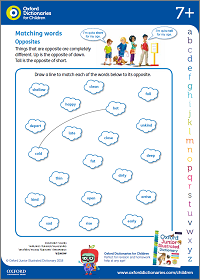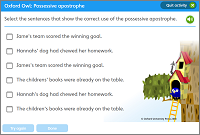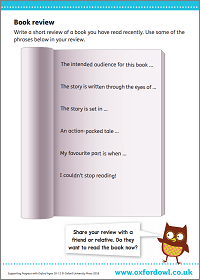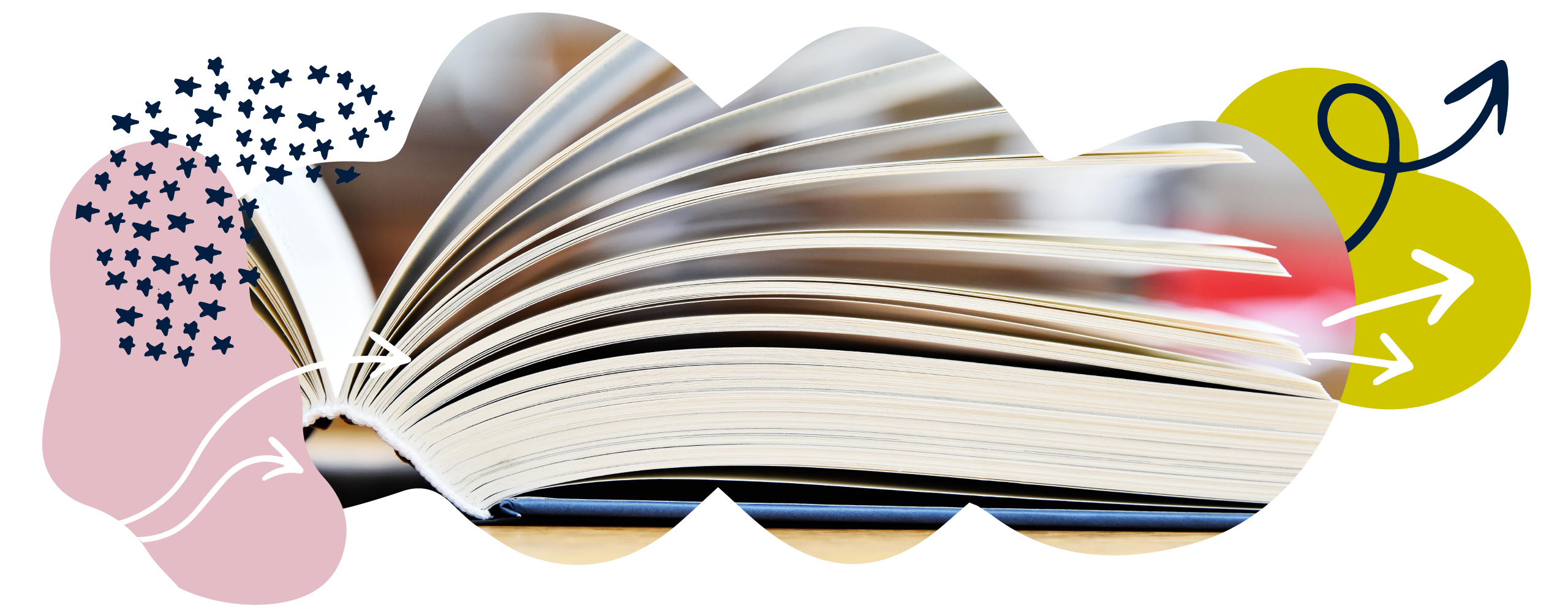Grammar and literacy glossary: A to C
Need a refresher on fronted adverbials or the passive voice? Get to know what your child is learning at school with our guide to common terms and phrases used in schools.
For help with general educational terms, take a look at the Education glossary.
For help with maths terms, take a look at the Maths glossary.
A | B | C | D | E | F | G | H | I | J | K | L | M | N | O | P | Q | R | S | T | U | V | W | X | Y | Z
Activity: Active and passive voice

Sort the sentences to show whether they are in the active or passive voice.
Video: What are active and passive sentences?
Learn the difference between active verbs and passive verbs.
Adverb
An adverb gives more information about a verb, an adjective, another adverb or a clause. An adverb tells you how, when, where or how often something happens.
Later, a cat crept up the tree as the little green bird eagerly pecked the juicy apple twice and ate it noisily.
Some adverbs make a comment or link ideas.
Fortunately, we won. However, the other team played well.
Some adverbs are used to say how likely or possible something is.
We’ll definitely come to the party.
Some adverbs are used for emphasis.
The bag was terribly heavy.
Adverbial
A word or phrase that gives more information about a verb or clause. An adverbial can be an adverb, a phrase or a subordinate clause.
The bird ate the apple noisily.
The cat sleeps all day.
We’ll play when we get home.
Fronted adverbials are adverbials placed at the beginning of a sentence. There is usually a comma after a fronted adverbial. Watch our short animation for more information.
Video: What are fronted adverbials?
Learn how and when to use adverbials for time, place, manner or number.
Alphabetic code
This code shows us the relationship between the sounds of our speech (phonemes) and the written letter(s) of the alphabet and how these are used to match those sounds.
Ambiguity
When something has more than one possible meaning.
‘I hate annoying people.’
This could mean ‘I do not like to annoy people’ or ‘I do not like people who are annoying’.
‘It is a large furniture shop.’
This could mean ‘It is a shop which sells large furniture’ or ‘It is a large shop which sells furniture’.
Antonym
Words that mean the opposite of each other, such as wet and dry, full and empty, open and closed. The opposite of an antonym is a synonym.
Activity: Opposites

Draw lines to match the words to their opposites.
Video: What are synonyms and antonyms?
Learn how to use synonyms and antonyms.
Apostrophe ‘
An apostrophe can be used to show when a word has been made shorter by dropping one or more letters. This is called a contraction. You usually use contractions in informal writing or when writing direct speech.
I am = I’m
did not = didn’t
could not = couldn’t
we are = we’re
you have = you’ve
she will/she shall = she’ll
An apostrophe can also show ownership or possession. This is called a possessive apostrophe. Possessive apostrophes show that something belongs to, or is for, someone or something. Often, a possessive apostrophe is used with a possessive s.
If a singular word doesn’t end in -s, add ’s:
The boy’s pen.
If a singular word ends in -s, add either ’s or just ’:
James’s hat; Nicholas’ hat.
If a singular word ends in -ss, still add ’s:
The princess’s crown.
If a plural ends in -s, just add ’:
The girls’ bags; the visitors’ car park; the calves’ horns.
If a plural doesn’t end in -s, add ’s:
Men’s coats.
Activity: Possessive apostrophe

Select the sentences that show the correct use of the possessive apostrophe.
Video: How to use apostrophes
Learn how and when to use apostrophes correctly, including possessive apostrophes.
Blending
To say the individual sounds that make up a word and blend them together to hear the whole word for reading (for example, ‘s-a-t’ becomes ‘sat’). We say you blend to read and segment to spell.
Video: How to blend sounds to read words
Suzy Ditchburn explains how letter sounds can be blended to read words.
Book bands
A system of grouping books in bands of colour to represent different levels of reading difficulty. Read more about book bands and reading levels.
Brackets ( )
Used to separate a word or phrase that has been added to a sentence as an explanation or afterthought. If you take out the word or phrase between the brackets, the sentence should still make sense.
My birthday cake was chocolate (which is my absolute favourite) with chocolate icing and chocolate buttons on top as well.
Bullet points
Used to organise a list of points in order to make it clear. The text introducing the list of bullet points should end with a colon.
We gave the following reasons for wanting to have a party:
- It was our last year in primary school.
- We wanted to say goodbye to our teachers.
- We had worked hard all year.
Luckily for us, the teachers agreed!
Clause
A phrase which has a verb as its head, or key word. The other words add meaning to the verb.
Main clause: A clause that can be used on its own as a sentence.
The bird pecked the apple. It flew away.
Main clauses can be joined with coordinating conjunctions such as ‘and’, ‘but’ and ‘or’.
The bird pecked the apple and it flew away.
Subordinate clause: A subordinate clause helps to give more meaning to the main clause. It cannot exist on its own as it is not a complete sentence. A subordinate clause often starts with a subordinating conjunction such as ‘although’, ‘because’, ‘before’, ‘if’, ‘since’ or ‘when’.
The bird pecked the apple before it flew away.
Relative clause: A type of subordinate clause. It is connected to the main clause by a relative pronoun such as ‘that’, ‘which’, ‘who’, ‘whom’ or ‘whose’.
I enjoyed the film that we saw last night.
Video: What are phrases and clauses?
Learn how to use sentences, phrases and clauses with our fun animation.
Video: What is a subordinate clause?
Learn the difference between a clause, a subordinate clause and a relative clause.
Cohesion
The ways in which the writer makes the different parts of a text link together, for example, by grouping sentences together in paragraphs using particular words and phrases to link ideas.
Cohesive device
A word or phrase that shows how the different parts of a text link together.
Use determiners and pronouns to link back to other words:
Mr Smith came in with his dog. The dog and he were both old.
Use a conjunction to link words or groups of words within a sentence.
Mr Smith and his dog were both old.
Use adverbs and adverbials to link between sentences.
I saw a robin in the garden. Later, I saw a green bird.
Use ellipsis when a word or phrase has already been used and does not need to be repeated again.
‘What do you want to eat?’ ‘A biscuit.’ [‘I want to eat’ has been missed out.]
Video: What are cohesive devices?
Learn how to use cohesive devices like determiners, pronouns, conjunctions, and adverbs.
Colon :
A colon can be used to introduce a list.
I love the following foods: apples, seeds, grapes, and nuts.
A colon can be used to introduce examples or explanations. The words after the colon give more information about what comes before it.
The bird eats lots of snacks: he needs lots of energy for flying.
You do not need to use a capital letter for the word that comes after a colon, unless it is a proper noun or the word ‘I’.
Colour-coded
Books are sometimes colour-coded in schools so that children choose a book from a similar level. The colours represent different levels of reading difficulty. Read more about book bands and reading levels.
Comma ,
A comma can be used to separate items in a list.
I like peas, carrots, beans and pizza.
Some texts use the serial, or Oxford, comma after the penultimate item in a list.
I ate an orange, an apple, and raspberries.
A comma can be used to change the meaning of a sentence.
I told him, honestly. I told him honestly.
A comma can be used to avoid ambiguity.
I’d like some jelly and ice cream for my sister. I’d like some jelly, and ice cream for my sister.
A comma can be used before a clause starting with ‘or’, ‘and’ or ‘but’.
Did you paint this picture yourself, or did someone help you?
A comma is used after a subordinate clause at the start of a sentence.
If we’re really quiet, we won’t disturb Grandad.
A comma is also usually used after a fronted adverbial.
With a shake, the dog dried itself off.
A comma is used to separate the name of the person being spoken to from the rest of the sentence.
Kids, dinner’s ready!
Command
A sentence that gives an order or instruction.
Take this food away!
A sentence that is a command or instruction is usually in the imperative, with the verb first. An exclamation mark can also come at the end of a command.
Comprehension
The understanding of a text; at its simplest, this may be an understanding of what the text is about (for example, the story is about a pumpkin).
At its most sophisticated, it is an understanding of what lies beneath a text (for example, the author’s experience, historical context, themes and so on). This is often referred to as the deeper levels of meaning, inferential comprehension, or higher order reading skills.
Activity: Comprehension

Use these phrases to write a short review of a book you have read recently.
Video: What is comprehension?
Learn how children build their understanding of a text using a combination of background knowledge, vocabulary, language structures and inference.
Conjunction
A conjunction links words or groups of words within a sentence.
A cat crept up the tree as the bird pecked the apple and ate it noisily.
Coordinating conjunction: A coordinating conjunction joins groups of words which are of the same importance in the sentence.
Bread and cheese; Jack and Jill.
Main clauses can be joined with coordinating conjunctions such as ‘or’, ‘and’, or ‘but’.
Subordinating conjunction: A subordinating conjunction introduces a subordinate clause, such as ‘after’, ‘although’, ‘as’, ‘because’, ‘before’, ‘if’, ‘since’, ‘when’ and ‘while’.
The cat watched the bird quietly because he didn’t want to scare it away.
Activity: Conjunctions

Drag a conjunction into each gap to join the clauses.
Consonant
Vowels are sounds represented by the letters ‘a’, ‘e’, ‘i’, ‘o’, ‘u’ and sometimes ‘y’. All other sounds are called consonants and are represented by the other letters in the alphabet, which are called consonant letters.
